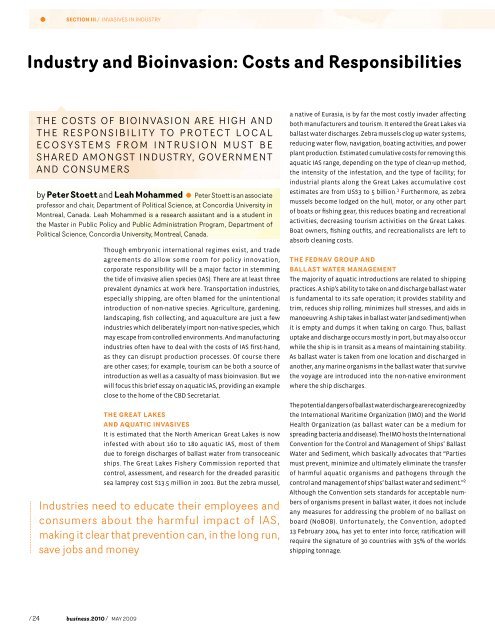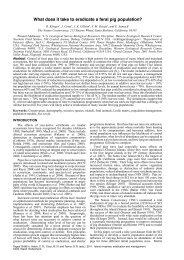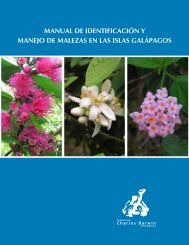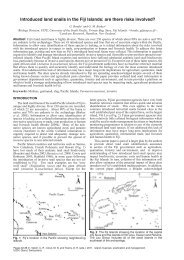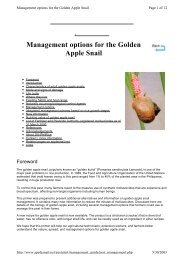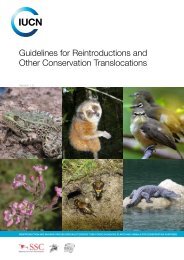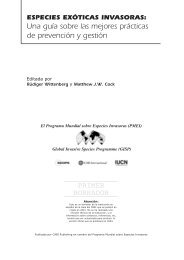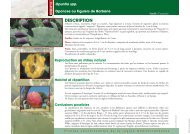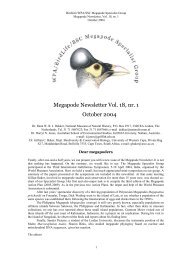Download pdf - IUCN Invasive Species Specialist Group
Download pdf - IUCN Invasive Species Specialist Group
Download pdf - IUCN Invasive Species Specialist Group
You also want an ePaper? Increase the reach of your titles
YUMPU automatically turns print PDFs into web optimized ePapers that Google loves.
Section iii / <strong>Invasive</strong>s in industry<br />
Industry and Bioinvasion: Costs and Responsibilities<br />
The costs of bioinvasion are high and<br />
t h e r e s p o n s i b i l i t y to p r o t e c t l o c a l<br />
ecosyS Tems from intrusion must be<br />
shared amongst industry, government<br />
and consumers<br />
by Peter Stoett and Leah Mohammed<br />
Peter Stoett is an associate<br />
professor and chair, Department of Political Science, at Concordia University in<br />
Montreal, Canada. Leah Mohammed is a research assistant and is a student in<br />
the Master in Public Policy and Public Admin istration Program, Department of<br />
Political Science, Concordia University, Montreal, Canada.<br />
Though embryonic international regimes exist, and trade<br />
agreements do allow some room for policy innovation,<br />
corporate responsibility will be a major factor in stemming<br />
the tide of invasive alien species (IAS). There are at least three<br />
prevalent dynamics at work here. Transportation industries,<br />
especially shipping, are often blamed for the unintentional<br />
introduction of non-native species. Agriculture, gardening,<br />
landscaping, fish collecting, and aquaculture are just a few<br />
industries which deliberately import non-native species, which<br />
may escape from controlled environments. And manufacturing<br />
industries often have to deal with the costs of IAS first-hand,<br />
as they can disrupt production processes. Of course there<br />
are other cases; for example, tourism can be both a source of<br />
introduction as well as a casualty of mass bioinvasion. But we<br />
will focus this brief essay on aquatic IAS, providing an example<br />
close to the home of the CBD Secretariat.<br />
The Great Lakes<br />
and Aquatic <strong>Invasive</strong>s<br />
It is estimated that the North American Great Lakes is now<br />
infested with about 160 to 180 aquatic IAS, most of them<br />
due to foreign discharges of ballast water from transoceanic<br />
ships. The Great Lakes Fishery Commission reported that<br />
control, assessment, and research for the dreaded parasitic<br />
sea lamprey cost $13.5 million in 2001. But the zebra mussel,<br />
Industries need to educate their employees and<br />
consumers about the harmful impact of IAS,<br />
making it clear that prevention can, in the long run,<br />
save jobs and money<br />
a native of Eurasia, is by far the most costly invader affecting<br />
both manufacturers and tourism. It entered the Great Lakes via<br />
ballast water discharges. Zebra mussels clog up water systems,<br />
reducing water flow, navigation, boating activities, and power<br />
plant production. Estimated cumulative costs for removing this<br />
aquatic IAS range, depending on the type of clean-up method,<br />
the intensity of the infestation, and the type of facility; for<br />
industrial plants along the Great Lakes accumulative cost<br />
estimates are from US$3 to 5 billion. 1 Furthermore, as zebra<br />
mussels become lodged on the hull, motor, or any other part<br />
of boats or fishing gear, this reduces boating and recreational<br />
activities, decreasing tourism activities on the Great Lakes.<br />
Boat owners, fishing outfits, and recreationalists are left to<br />
absorb cleaning costs.<br />
The Fednav <strong>Group</strong> and<br />
Ballast Water Management<br />
The majority of aquatic introductions are related to shipping<br />
practices. A ship’s ability to take on and discharge ballast water<br />
is fundamental to its safe operation; it provides stability and<br />
trim, reduces ship rolling, minimizes hull stresses, and aids in<br />
manoeuvring. A ship takes in ballast water (and sediment) when<br />
it is empty and dumps it when taking on cargo. Thus, ballast<br />
uptake and discharge occurs mostly in port, but may also occur<br />
while the ship is in transit as a means of maintaining stability.<br />
As ballast water is taken from one location and discharged in<br />
another, any marine organisms in the ballast water that survive<br />
the voyage are introduced into the non-native environment<br />
where the ship discharges.<br />
The potential dangers of ballast water discharge are recognized by<br />
the International Maritime Organization (IMO) and the World<br />
Health Organization (as ballast water can be a medium for<br />
spreading bacteria and disease). The IMO hosts the International<br />
Convention for the Control and Management of Ships’ Ballast<br />
Water and Sediment, which basically advocates that “Parties<br />
must prevent, minimize and ultimately eliminate the transfer<br />
of harmful aquatic organisms and pathogens through the<br />
control and management of ships’ ballast water and sediment.” 2<br />
Although the Convention sets standards for acceptable numbers<br />
of organisms present in ballast water, it does not include<br />
any measures for addressing the problem of no ballast on<br />
board (NoBOB). Unfortunately, the Convention, adopted<br />
13 February 2004, has yet to enter into force; ratification will<br />
require the signature of 30 countries with 35% of the worlds<br />
shipping tonnage.<br />
/ 24 business.2010 / may 2009


